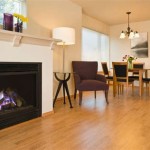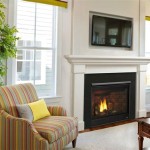Gas Log Fireplace Installation: A Comprehensive Guide
Gas log fireplaces offer a convenient and aesthetically pleasing alternative to traditional wood-burning fireplaces. These systems provide the ambiance of a real fire without the hassle of sourcing, storing, and cleaning up wood. However, the installation of a gas log fireplace requires careful planning, adherence to safety regulations, and a thorough understanding of the components involved. This article provides a comprehensive overview of the gas log fireplace installation process.
The popularity of gas logs stems from several advantages. They eliminate the need for firewood, reducing the effort associated with traditional fireplaces. Gas logs produce minimal ash and creosote, simplifying maintenance and reducing the risk of chimney fires. Additionally, they offer instant ignition and adjustable flame height, providing greater control over heat output and ambiance. However, correct installation is paramount to ensure safe and efficient operation.
Preparing for Gas Log Installation
Before embarking on the installation process, several preliminary steps are essential. These steps ensure compatibility, safety, and compliance with local regulations. Careful preparation minimizes potential problems and ensures a smooth installation process.
First, the existing fireplace must be thoroughly inspected. This inspection should assess the condition of the firebox, chimney, and damper. Cracks, leaks, or other structural damage must be addressed before proceeding. A professional chimney sweep should clean the chimney to remove any accumulated creosote or debris. This cleaning reduces the risk of chimney fires and ensures proper ventilation.
Next, the homeowner must choose the appropriate type of gas logs. Gas logs are available in vented and ventless options. Vented gas logs require a fully functional chimney that remains open during operation, allowing combustion byproducts to escape. Ventless gas logs, on the other hand, burn more efficiently and do not require a fully open chimney. However, ventless logs produce small amounts of carbon monoxide and require a carbon monoxide detector in the room. Local building codes often dictate which type of logs are permitted.
The type of gas connection must also be determined. Natural gas and propane are the two primary fuel sources for gas log fireplaces. The existing gas line must be compatible with the selected gas logs. If a gas line is not already present, a qualified gas technician must install one. It’s crucial to verify the gas pressure to ensure it meets the requirements of the gas log set. Insufficient gas pressure can lead to poor flame quality and inefficient operation.
Finally, all necessary permits must be obtained from the local building department. Permit requirements vary depending on the location and the scope of the project. Obtaining the necessary permits ensures compliance with local building codes and safety regulations. Failure to obtain permits can result in fines and delays.
The Installation Process: Step-by-Step
The installation of a gas log fireplace involves several key steps, each requiring careful attention to detail. Following these steps meticulously ensures a safe and functional fireplace.
The first step is to prepare the firebox. This involves removing any existing grates or fire debris. The firebox should be clean and free of obstructions. The gas line connection point should be readily accessible. If the existing firebox is damaged, it may require repair or relining before proceeding. The firebox floor should be level to ensure proper log placement.
Next, the gas valve and burner assembly are installed. This assembly is the heart of the gas log fireplace and controls the flow of gas to the logs. The gas valve is typically mounted in the firebox and connected to the existing gas line. A qualified gas technician should make this connection, ensuring a gas-tight seal. The burner assembly is then placed on the firebox floor, aligning it with the gas valve. The burner assembly must be securely mounted to prevent it from shifting during operation.
Once the gas valve and burner assembly are installed, the gas logs are placed on top of the burner. The logs are typically arranged in a specific pattern to create a realistic flame appearance. The manufacturer's instructions should be followed carefully to ensure proper log placement. Incorrect log placement can obstruct the burner vents and lead to incomplete combustion. Some gas log sets include decorative ember materials that are placed around the logs to enhance the aesthetic appeal.
After log placement, the gas line connection is tested for leaks. A leak detection solution is applied to all gas connections, including the gas valve, burner assembly, and gas line. Any bubbles indicate a gas leak, which must be corrected immediately. Tightening the connections or replacing the fittings may be necessary to eliminate leaks. The gas line should be retested after any repairs are made.
Finally, the gas log fireplace is tested. The gas valve is turned on, and the burner is ignited. The flame should be stable and consistent. The flame height can be adjusted using the gas valve controls. The fireplace should be monitored for any unusual odors, noises, or drafts. The carbon monoxide detector should be checked to ensure it is functioning properly. The entire system should be allowed to run for a period of time to ensure proper operation and ventilation.
Safety Considerations and Maintenance
Safety is paramount when installing and operating a gas log fireplace. Adhering to safety guidelines and performing regular maintenance minimizes the risk of accidents and ensures long-term performance.
Carbon monoxide poisoning is a serious risk associated with gas appliances. All homes with gas log fireplaces should have working carbon monoxide detectors installed on each level. These detectors should be tested regularly to ensure they are functioning properly. Symptoms of carbon monoxide poisoning include headache, dizziness, nausea, and confusion. If these symptoms are present, the fireplace should be turned off immediately, and the area should be ventilated.
Proper ventilation is essential for gas log fireplaces. Vented gas logs require a fully functional chimney that remains open during operation. Ventless gas logs require adequate ventilation in the room to prevent the buildup of carbon monoxide. The manufacturer's instructions should be followed carefully to ensure proper ventilation. If there are concerns about ventilation, a qualified HVAC technician should be consulted.
Regular maintenance is crucial for gas log fireplaces. The logs should be cleaned periodically to remove dust and debris. The burner assembly should be inspected for any clogs or corrosion. The gas valve should be checked for leaks. The chimney should be inspected annually by a professional chimney sweep. Any necessary repairs should be made promptly.
It is important to never operate a gas log fireplace with flammable materials nearby. Curtains, furniture, and other combustible items should be kept a safe distance from the fireplace. Children and pets should be supervised closely when the fireplace is in operation. A fireplace screen can provide an additional layer of protection.
If any unusual problems are detected with the gas log fireplace, it should be turned off immediately, and a qualified gas technician should be consulted. Attempting to repair the fireplace without proper training and experience can be dangerous. Regular professional inspections and maintenance will help ensure the safe and efficient operation of the gas log fireplace for years to come.
The complexity of gas log fireplace installation often necessitates the expertise of qualified professionals. Engaging licensed gas technicians and certified chimney sweeps ensures adherence to safety standards and building codes. These professionals possess the knowledge and experience to handle gas line connections, ventilation requirements, and combustion safety concerns. While DIY installation might seem appealing, entrusting the task to professionals minimizes risks and guarantees a properly functioning and safe gas log fireplace system.

How To Select And Install A Gas Fireplace Log Set Fireplaces Direct Learning Center

How To Select And Install A Gas Fireplace Log Set Fireplaces Direct Learning Center

How To Put In A Gas Log Set For Fireplace

Fireplace And Gas Log Lighting Instructions

Gas Log Set S Installation Vented Logs For Your Fireplace
.png?strip=all)
How To Install A Log Lighter Fireplace Gas Starter Pipe

Convert A Wood Fireplace To Gas Full Service Chimney

Gas Fireplace Installation Repair Wilmington Nc Parker

Can I Install Gas Logs In My Existing Fireplace Thomas Bros Propane
How To Install Gas Fireplace Insert Heat Glo








